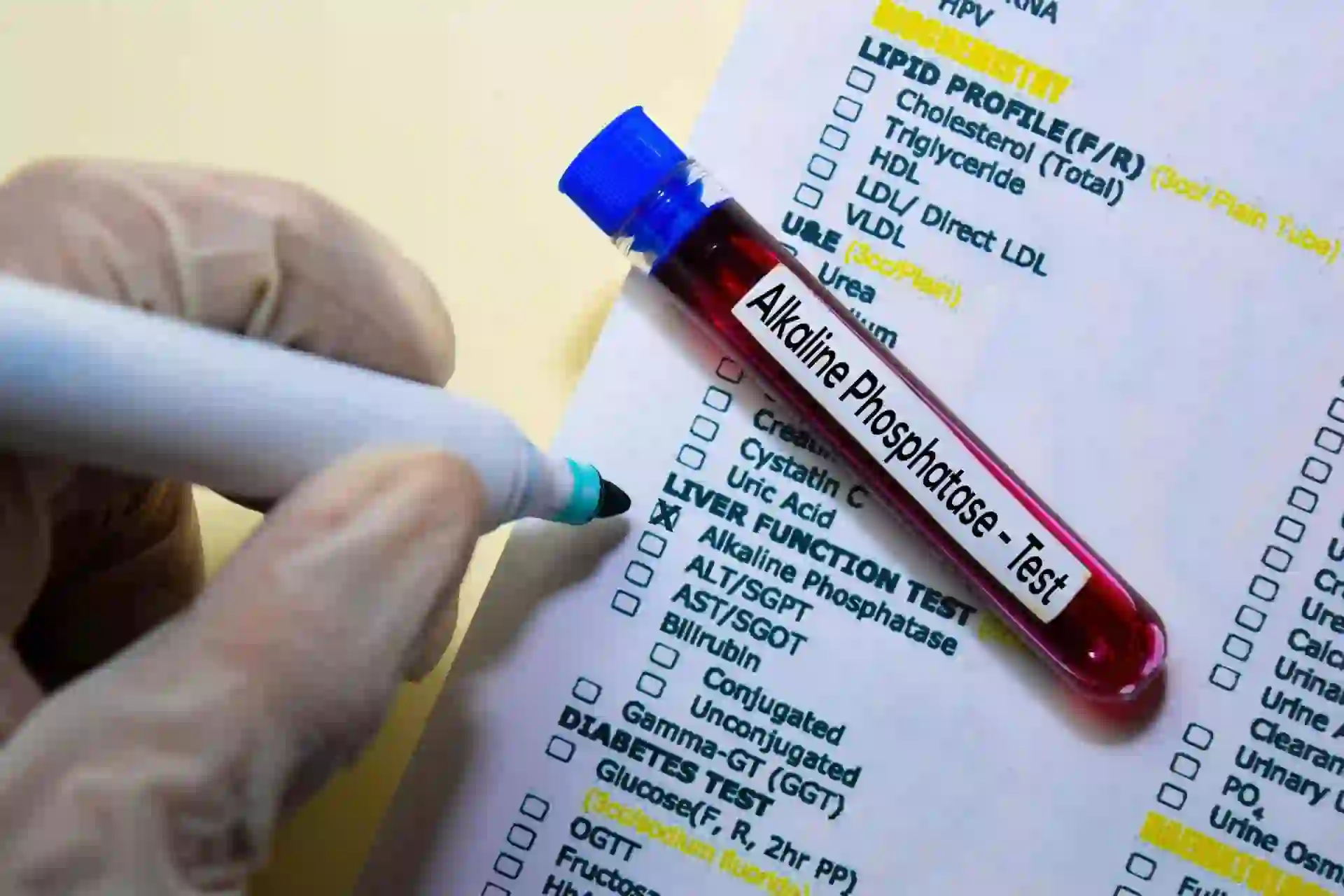What Level of Alkaline Phosphate is Dangerous?
What is Alkaline Phosphatase?
Alkaline phosphatase (ALP) is an enzyme found in many parts of the body, with high concentrations found in the liver, bile ducts, and bones. It plays an important role in multiple physiological processes.
A blood test can show if you have normal or abnormal alkaline phosphatase levels. But What level of alkaline phosphate is dangerous?
Normal Alkaline Phosphatase Range
The normal range can vary slightly depending on the laboratory conducting the test and a person’s age. However, a normal alkaline phosphatase level is generally considered to be 20 to 140 units per liter (U/L).
Normal ALP levels can vary based on a person’s age and the lab where the test was analyzed. However, typical reference ranges are:
- Children: 180-500 units/liter (U/L)
- Adolescents: 105-490 U/L
- Adults: 30-130 U/L
Moderate ALP Elevations
ALP levels that are persistently elevated in the 200 to 300 U/L range typically warrant further evaluation but are not emergencies initially. Ongoing monitoring of moderate elevations is prudent to check for a rapidly rising trend.
Conditions that can cause modest ALP increases include autoimmune hepatitis, primary biliary cholangitis, intestinal blockages, hypothyroidism, and some medications.
High and Dangerous ALP Ranges
When ALP levels exceed 300 U/L, they are considered significantly elevated. Levels over 500 U/L indicate issues with bone formation or bone destruction and risks for fractures, deformities, and osteoporosis.
Levels from 500 to 1,000 U/L suggest worsening liver disease like viral or alcohol-induced cirrhosis. Extreme ALP levels over 1,000 U/L indicate critical illness involving liver failure, cancer, or severe bone loss needing rapid treatment.
Causes of High Alkaline Phosphatase
There are many possible reasons for elevated ALP levels. The most common causes include liver disease like hepatitis or cirrhosis, bone disorders like Paget’s disease, rapid bone growth in children/teens, pregnancy, and certain medications or supplements.
Liver Disease
Some of the most common liver-related conditions that can raise alkaline phosphatase levels include:
- Viral hepatitis – Inflammation from hepatitis viruses can obstruct bile flow and cause high ALP.
- Cirrhosis – Liver scarring from chronic liver disease limits bile flow leading to increased ALP.
- Cholestasis – Any condition blocking bile made by the liver leads to elevated ALP. Gallstones and infections are common causes.
- Cancer – Liver cancers or metastatic cancers reaching the liver can produce excess alkaline phosphatase.
- Fatty liver disease – When fats abnormally accumulate in liver cells, liver enzyme levels like ALP often rise.
Bone Disorders
Since alkaline phosphatase is found in large amounts in bone tissue, diseases affecting bone growth and remodeling raise ALP levels in the bloodstream. Examples include:
- Paget’s disease – This disorder causes excessive, uncontrolled bone cell activity leading to misshapen bones.
- Rickets – A softening and weakening of bones often due to vitamin D deficiency. Mainly affects children.
- Osteomalacia – The adult version of rickets causes weak, brittle bones and bone pain.
- Bone fractures – The healing process of severe bone fractures releases extra alkaline phosphatase into the blood temporarily.
- Bone cancer – Cancers originating in the bone or metastasizing to the bone cause very high ALP levels.
Other Causes
Some less common diseases that can increase alkaline phosphatase concentrations include:
- Hyperthyroidism and hypothyroidism – Thyroid disorders affect multiple enzyme levels.
- Intestinal diseases – Bowel obstructions stop bile flow to the intestines increasing ALP.
- Some cancers – Certain cancers even without liver or bone spread can still raise ALP for unclear reasons.
- Medications – Certain prescriptions especially anticonvulsants are linked with mild ALP elevations.
In some of these cases like bone issues or growing children, the moderately elevated level may not necessarily be dangerous. However, a high level of signaling liver dysfunction often does require treatment.
Dangers of Highly Elevated Alkaline Phosphatase
Extremely high levels of alkaline phosphatase over 400 U/L are almost always a cause for concern and further evaluation. Some potential dangers of highly elevated ALP include:
- Bone loss: Very high ALP indicates rapid bone turnover that may lead to Bone fractures or deformities if not corrected.
- Bone Fractures: Increased bone turnover releases excess minerals leading to porous, fragile bones prone to fractures.
- Liver Failure: As liver function declines, bilirubin accumulates in the blood causing jaundice and eventually life-threatening liver failure.
- Cancer Spread: Certain aggressive cancers spreading to the liver and bones spur very high ALP synthesis.
- Death: Research correlates significantly elevated ALP with higher mortality rates when underlying diseases are not treated promptly.
By recognizing the risks of persistently high ALP levels over 300 to 500 U/L, steps can be taken to treat the root causes whether related to liver dysfunction, bone disorders, or cancer.
Aggressively lowering extremely high levels is crucial for positive outcomes. Consistent testing combined with proper treatment guided by a physician provides the best protection against further health deterioration. Being aware of ALP trends offers vital insight into overall wellness.
The enzyme known as alkaline phosphatase (ALP) is found in many different bodily tissues. When blood levels of ALP are elevated, it can indicate issues with the liver, gallbladder, or bones depending on which isoenzyme is affected.
Mildly elevated ALP usually does not produce symptoms initially but can be a sign of an underlying condition that needs treatment. If ALP levels continue rising to dangerously high levels, potentially serious complications can occur.
Treating high alkaline phosphatase levels
Treat Underlying Condition
The priority is to diagnose and treat the underlying disease causing increased ALP blood concentrations. This may involve:
- Medications – Disease-specific drugs to reduce liver inflammation, improve bile flow, stabilize bones, etc.
- Surgery – Procedures like cholecystectomy to remove gallstones obstructing bile ducts or tumor removal that spreads cancer.
- Chemotherapy – Powerful medications to combat certain liver cancers and metastatic bone cancers.
- Lifestyle changes – Diet and nutrition changes to improve liver function and bone health. Sometimes stopping causative medications.
Supportive Care
While treating the root condition, supportive care helps manage symptoms from elevated ALP complications:
- Pain relievers – Over-the-counter pain medication and prescription narcotics to relieve bone pain.
- Fracture care – Splinting, orthopedic casts, or stabilizing metal plates depending on fracture severity.
- Nutrition therapy – Adequate hydration and providing all essential nutrients when liver disease impedes diet.
Serial Testing
Follow-up blood tests to monitor ALP levels are key after starting treatment. Levels should gradually decrease if interventions succeed. Rising ALP indicates treatment failure and the need to change management strategy.
In summary, combining specific treatments to address the underlying source of high ALP along with supportive therapy and consistent testing offers the best odds of getting elevated alkaline phosphatase back into the normal range. Bringing levels under control is important for both short-term comfort and long-term health.
Summary
- Alkaline phosphatase (ALP) is an enzyme found throughout the body with important roles.
- Normal ALP levels range between 30-140 units/liter (U/L) in adults typically.
- High ALP levels can indicate issues like liver disease, bone disorders, cancers, or other conditions.
- Mild elevations between 150-250 U/L may just need monitoring without treatment.
- Moderate levels between 250-400 U/L often need medical care but are usually manageable.
- Levels exceeding 400-500 U/L are considered dangerously high and require prompt treatment.
- Very high levels over 1,000 U/L indicate life-threatening liver failure or advanced cancer.
- Letting ALP levels stay elevated poses threats like bone fractures, liver failure, cancer spread, and higher mortality rates if not treated.
FAQs
How high is too high for alkaline phosphatase levels?
Alkaline phosphatase levels above 400-500 U/L are considered dangerously high and require medical treatment.
What causes extremely high ALP levels over 1,000 U/L?
Levels reaching over 1,000 U/L indicate critical organ damage usually from liver failure or advanced cancer.
Are mild ALP elevations between 150-250 dangerous?
Mild elevations in this range simply need periodic monitoring and may not require treatment right away if there are no symptoms.
What problems can ongoing high alkaline phosphatase levels cause?
Allowing ALP levels to stay elevated can lead to brittle bones and fractures, liver failure, metastasis of cancers, and increased mortality risk if the underlying condition is not treated.
How do doctors treat high ALP levels?
Doctors focus on treating the underlying disease causing the elevated ALP, along with supportive care for specific symptoms manifesting. Serial blood tests monitor ALP response to treatments.
References
- S. (2023, October 31). What Level Of Alkaline Phosphatase Is Dangerous – Statcare. https://statcarewalkin.com/info/what-level-of-alkaline-phosphatase-is-dangerous.html
- Huizen, J. (2023, January 4). What do abnormal ALP levels mean? https://www.medicalnewstoday.com/articles/321984
- Professional, C. C. M. (n.d.). Alkaline Phosphatase (ALP). Cleveland Clinic. https://my.clevelandclinic.org/health/diagnostics/22029-alkaline-phosphatase-alp#test-details
- Bs, J. C. (2022, December 15). High Alkaline Phosphatase Symptoms & How to Reduce It. SelfDecode Labs. https://labs.selfdecode.com/blog/alkaline-phosphatase/






